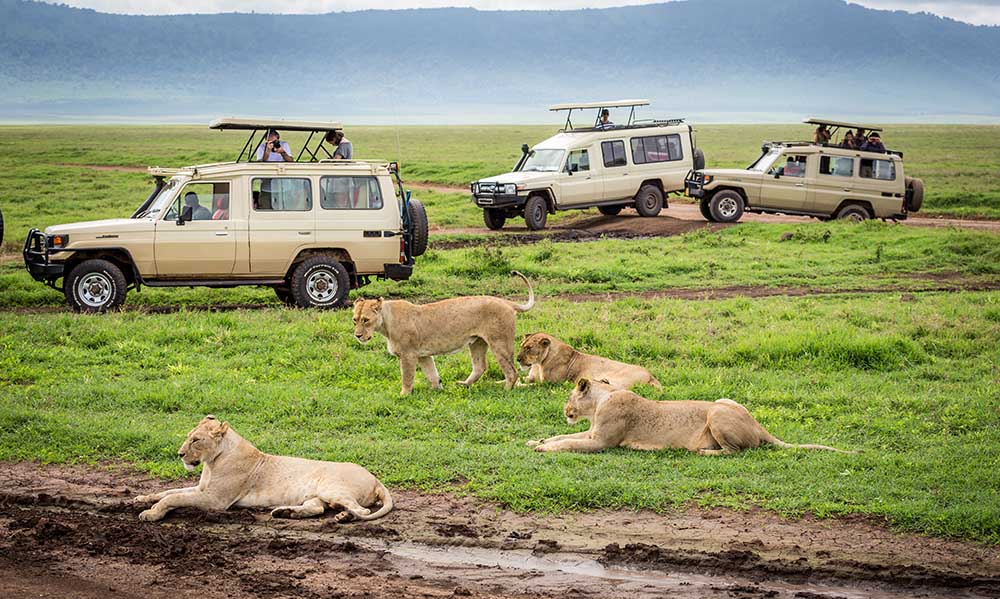
Overview – Ngorongoro Crater
A visit to the Ngorongoro Crater is an experience of a lifetime. There are few places that have wildlife densities and variety on this level. It is not unusual to see the Big Five in one day – and all this in the most amazing setting with a backdrop of the 600m/1,968ft-high crater wall.
Wildlife & Animals – Ngorongoro Crater
The star attraction of the Conservation Area is the Ngorongoro Crater: an extinct volcano teeming with wildlife. All major animals are easily seen. The only exception is the giraffe, which is present in the Conservation Area, but not in the crater because of the steep descent. Elephants are common, including some very big tuskers, and all the big cats are prominent as well.
Wildlife Highlights
A real special of the crater is the black rhino. Rhino is hard to see in Tanzania and usually sticks to thick vegetation. This is not so in the crater, where they have a predictable routine of spending the night in Lerai forest, and the day in open grassland. Black-backed and golden jackals are equally common in the crater and the density of spotted hyenas is quite extraordinary.
Best Time for Wildlife Viewing
Wildlife viewing is excellent in the crater throughout the year. The scenery of the crater is most spectacular in the Wet season, from November to May, but at that time the grass might be long in places. This can interfere with seeing some of the smaller animals. March and April are the wettest months.
Scenery
The Ngorongoro Conservation Area is stunningly beautiful. Aside from the well-known Ngorongoro Crater, Empakaai and Olmoti craters are scenic highlights as well. Both the Ngorongoro and Empakaai craters regularly have flocks of flamingo. The forested crater rim of the Ngorongoro Crater is in stark contrast with the crater floor, which consists mostly of grassland. Another feature on the crater floor is Lerai forest, a beautiful, atmospheric, yellow fever tree forest.
Weather & Climate – Ngorongoro Conservation Area
Ngorongoro Conservation Area has a mild, temperate climate. The area experiences two Wet seasons. From October to November are the ‘short’ rains, followed by the ‘long rains’ from March to May. Rainfall is usually experienced in the form of short showers. The crater never gets very hot during the day, but the crater rim gets cold, and it can freeze at night. Warm clothing for early morning game drives is a necessity.
Ngorongoro CA’s climate compared to the Ngorongoro Crater
The Ngorongoro Conservation Area is a vast area with altitudes ranging from 1,027 to 3,522m (3,369-11,555ft). Most people only visit the Ngorongoro Crater. They spend the night in a lodge or campsite on the crater rim and visit the crater floor for wildlife viewing.
Both the rim (about 2,300m/8,530ft) and floor (about 1,700m/5,577ft) are at higher altitudes and are colder than the overall conservation area. Temperatures drop by about 6.5°C for every 1,000m you climb (or 3.5°F per 1,000ft).
The difference is more noticeable during the night. Afternoons on the crater floor will be pleasant, but they can freeze on the crater rim at night. The rim also receives quite a lot of rain.
Dry season – June to October
June, July, August, September & October – Afternoon temperatures are usually around 19°C/66°F on the crater floor. Sunny, cloudless skies are normal, but if the ‘short rains’ arrive early, they could begin in October. It gets cold at night, and it can freeze on the crater rim.
Wet season – November to May
It gets warmer during the day when compared to the Dry season, but mornings are still cold. Afternoon temperatures are usually around 23°C/73°F on the crater floor, while night temperatures are around 6°C/43°F on the crater rim.
November & December – ‘Short rains’ – These rains are highly unlikely to impact your safari as it won’t rain all day. Showers usually happen in the afternoon. The ‘short rains’ last about one month and can occur anytime between October and December.
January & February – It isn’t possible to guess when it will happen with accuracy, but there is usually a time of dry weather between the Wet seasons.
March, April & May – ‘Long rains’ – It often rains, but it rarely lasts the entire day. April and May could experience very chilly conditions due to cold fronts.
